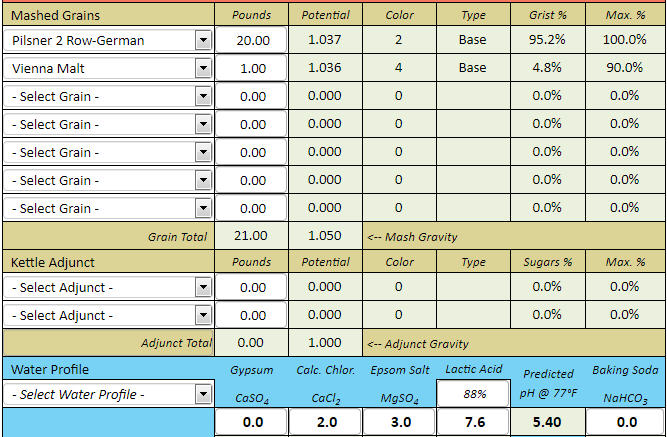I think of may have found (by careful reading of his last post - which, be honest guys, we don't always do) the problem in Martin's reasoning which
could be responsible the problem you guys are seeing with Bru'n water. They key paragraph is
The scenario above is simplified when zero alkalinity DI water is employed. The acid demand becomes AB mEq. When the mashing water volume is altered, the acid quantity AB remains unchanged in the scenario.
So far, so good.
Since pH is the concentration of protons in solution, it should be apparent that altering the mash's water/grist ratio will proportionally alter the pH.
Now here's where we run into trouble. It would seem that he is assuming that the added protons (AB mEq of them) are distributed between the malt and the water in a way other than the way they actually are. The bases in the malt (lets throw out doubly dissociated succinate with its second pK of 5.6 as an example: H+ + Suc-- --> HSuc-) are much stronger bases than water is and so they grab the lion's share of the protons with only a small fraction going to protonate water. The quantity taken by the water is approximately 1000*(10^(-pHz) - 10^(-pHs)) in which pHz and pHs are, respectively, the pH at which the water ultimately arrives. It is computed by choosing a trial pH, determining the charge on the water and the charge on the malt bases. The sum must be 0. If it is greater than 0 the pH is too low and another, higher pH is tried. If it is negative then the trial pH is too high and a lower pH is tried until the value which zeroes the charges is found. This is the pH at which the mash will settle.
As indicated in my first response to the OP about 57.2 mEq of protons would be needed for the first scenario of which only 1.2 mEq go to protonate water (H+ + H2O --> H3O+; pH is
approximately the concentration of H3O+). The remaining 56 go to protonate molecules of malt bases (H+ + malt_ate- --> Hmalt_ate).
If the amount of malt is doubled but the amount of water left the same the requirement for the malt doubles to 112 but the requirement, for the same pH, for the water remains the same: 1.2 mEq. If the amount of water is also doubled then another 1.2 mEq of protons will be needed to acidify that second 10 gal water to pHz, the target pH. This makes the total requirement 114.4. So, in fact, increasing the amount of DI water used in a mash does make a wee difference (because even DI water has alkalinity) but as the fraction that goes to the water is so small it can be ignored in back-of-the-envelope calculations.
When alkalinity is present in the mashing water, it should again be apparent that additional acid protons are required when the quantity of water is increased. Software that doesn't reflect that water/grist ratio pH variation would not be very accurate.
In the case of DI water the variation in water to grist ratio can be ignored to quite good accuracy. Ignoring the water's requirement causes an error of 1.2/57.2 = 2.1% in Scenario 1. I chase errors of that magnitude and so include the water component in all my alkalinity calculations. Others don't.
Thus when Martin says that even with DI water a program than ignores mash thickness "would not be very accurate" it hints that he doesn't understand what it written above (which he really, really, needs to understand) but it does not explain how his program comes up with no increased acid requirement when malt doubles. Is he somehow conflating malt alkalinity and water alkalinity? I really don't know but think that his problem must be rooted in that part of the forest.





















![Craft A Brew - Safale S-04 Dry Yeast - Fermentis - English Ale Dry Yeast - For English and American Ales and Hard Apple Ciders - Ingredients for Home Brewing - Beer Making Supplies - [1 Pack]](https://m.media-amazon.com/images/I/41fVGNh6JfL._SL500_.jpg)




































